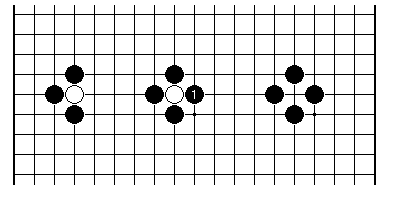

So you want to learn to play Go? I could teach you here and now, on the back of an envelope. It would only take five minutes. But I know somewhere with a bit of atmosphere. It's in an ideal world, true, but after a while you'll really not notice.
As we cross town I tell you something about the past of the game of Go. Among board games and mind sports it is certainly an aristocrat. The problem with dukes who introduce themselves with their whole family history is that you may wonder if they have any other topic of conversation. Go was around in 500 BC or so in China, and is thought to have been played continuously since then, with little essential change. I don't insist on the details, and you look a bit relieved.
Dan's has a small frontage on the street, but leads to a substantial room full of tables with Go equipment: a thick wooden board, two turned bowls holding the pieces (called stones). At the back WALLACE is playing with the GREY PANTHER. Don't be fooled by the silver hair. You don't want to tangle with those guys until you have a very clear idea of what you're doing. Looking on impassively is GOLD, the local champion. He's interested, rather than impressed. Next to them SKODAMAN is playing with BUTCHERBOY. A much quicker game, and in fact it finishes as we come in. SKODAMAN gestures at one part of the board, utters a few words of self-criticism by way of resignation, and starts piling Go stones (lens-like in shape and made of opaque glass) back into his own bowl.
There are other players in tonight. BART, a young person, is finishing a soft drink in a can with plenty of superfluous noise. In a quiet corner SIMMONDS is concentrating, leaning forward slightly with her hands on her hair. Her opponent is unknown to me, perhaps a visitor passing through.
We need a quiet place ourselves. Seated at a board I run over the basic rules. There are two players, one taking the black stones and one taking the white stones. They play alternately.
It turns out that you've played Othello, giving you
a flying start in appreciating the fundamentals of
Go. Both are games of territory: the object can be
described broadly as trying to control more of the
playing area than your opponent. Both are played on
a grid, a square board ruled into smaller squares.
I point out to you that the Go board in front of us
has a grid on it, but in fact is rectangular - it is
slightly elongated, meaning that as you sit at the
board foreshortening restores the impression that it
is square.
In Go, the stones are placed on the
intersections of the grid, not in the small squares.
The full-size board is 18 squares by 18, making a 19 by
19 grid of intersections. This is the standard
size all over the world. Smaller boards can be used for
teaching, and I'll rustle one up from somewhere, when
you first get down to playing.
The play of the game is solely by occupying
intersections, usually called "points". Each player
in his or her turn takes a stone from the bowl, which
should initially contain 150 or so, and places it on
a vacant point on the board. The choice of where to
play is restricted only by a couple of secondary
rules, to which we'll return. Normally there are a
hundred or more possibilities. At the start of the game
the board is empty, and the game position builds up
gradually until the end of the game. We'll have to talk
about that some more later.
Fortunately here in
a club we can stroll over and have a look at games in
their final stages. I'll mark your card about all that -
we'll find some good-natured players and inspect their
territories as they finish them off. The thing to grasp
right now is that the game continues until both players
agree it is over.
What I've told you so far isn't enough to make a game of it. The stones once placed don't move on the board, but there is a mechanism for capture (again like Othello). That's the one thing I'd like to teach you formally tonight. Once you get hold of the capture rule in Go, everything else will start to slot into place. Territory is only yours, beyond dispute, if you can capture any stones your opponent plays inside it.
By placing one of your stones you may succeed in capturing one or more of your opponent's stones. When you capture a single stone it is in one of three basic patterns. We'll look at these first.

First, the most fundamental pattern. I show you this in comic-strip fashion. From left to right: before Black plays here; as Black plays a stone to the right of the single white stone; after Black removes the white stone (traditionally into the safe-keeping of the lid of Black's bowl, for later scoring). Do you understand?
In the time-honoured tradition of pupils, you do, but bring up something off-topic that is bothering you. Those small black dots on the board? Don't worry. They don't enter the play of the game; they mark where handicaps may be placed, and help to break up the board visually.
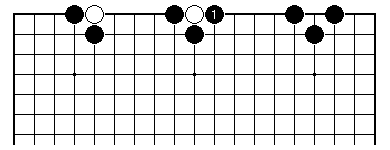
In the same way there is a basic pattern for Black to capture a single white stone on the edge. Again I show you this in three steps. Just as before Black instantly takes off and keeps the white stone.
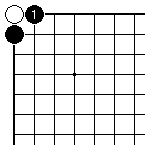
I see you are catching on fast, so I give you the pattern for capture in the corner straight. By playing the black stone indicated as '1', Black takes the white stone, leaving the corner clear.
That is far from all, though. Of course White can take black stones as well. But larger units, that I'll call "chains", may be captured. Two, three or even four chains may be captured in a single play.
There are too many possible shapes of chain for me to show you all of them - at some point I have to rely on you picking up the principle involved.
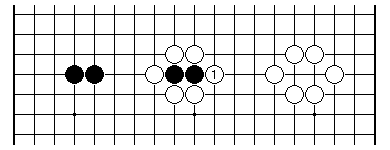
Two stones of the same colour on adjacent points certainly make up a chain. Chains are in fact all the shapes you can make up by starting with a stone placed on the board, and successively adding stones of the same colour adjacent to one already placed. With two black stones as a chain in the middle of the board, White has to place six stones adjacent to Black's to complete the capture. Look at the comic-strip, to see the stone White 1 being placed to finish the job, and the resulting White formation, after White removes the two black stones, often called prisoners.
We could spend all evening on this, but let's fast-forward to bigger chains and the general rule.
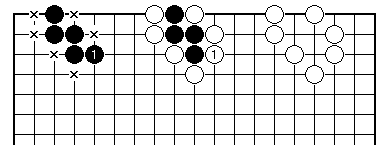
Here is a black chain of four stones already in place. Black 1 as shown makes it a five-stone chain. There are other points, marked with letter 'x', where Black could have connected on one more stone. These are also the key points for the capture rule. Suppose White has occupied all these points, as shown in the centre of the diagram. If the white stone marked 1 is played to fill in the last such point, called a liberty, the black chain is captured. The remaining all-white formation is shown on the right.
Putting this in other words: every chain has a certain number, at least one, of so-called liberties. These are points adjacent to the chain, growth points in the sense that the chain can be added to there. When a player plays on the last liberty of one of the opponent's chains, that chain is captured and taken off at once.
This means you should never see on a go board a chain that has no liberties - it should already have been removed. Chains can twist around and back on themselves, but keeping track of their liberties becomes second nature after a little while.
There are two matters that often throw people.
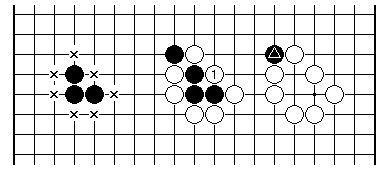
Firstly, this three-stone black chain has seven liberties marked with 'x'. Looking at the centre formation, White 1 does succeed in filling the last one of them, and so the black chain is captured. One black stone, the one with a triangle drawn on it, is left behind. Is this correct? Yes, that black stone wasn't part of a chain with the three stones: it wasn't sitting on a liberty of any of them, but is a chain of one in its own right. It didn't get captured with the others, but also it was of no help to them, since it wasn't connected. Equally, White had no need of a stone on that point to capture the black chain.
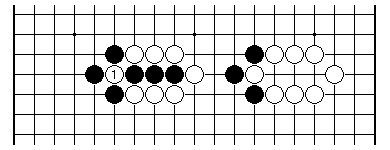
The other is to do with playing into a "captured"
position. With White 1, White claims the capture of
three black stones, leaving the right-hand position.
Should Black though shout "Oy, not so fast, White 1 was
captured as soon as it touched the board?".
No, White is correct here. The position must be resolved one
way or the other, since chains without liberties cannot
remain on the board. But the capture rule, formally
stated, makes it clear that playing to create a chain of
your own with no liberties is legal, provided you
are making an immediate capture. In that way no illegal
position arises.
I start in on some talk about chains and the polyominoes of recreational mathematics; but I see your attention is flagging. Fortunately there is a distraction: a crowd is gathering round PINK and SCOUT as they play. Probably a big capturing race going on. We wander over to investigate.
First published 31 January 2000 as On Your Side on MindZine,
Go Learning
© Charles Matthews 2000.